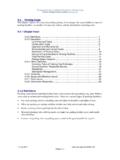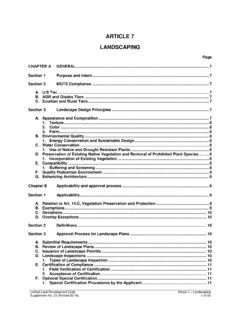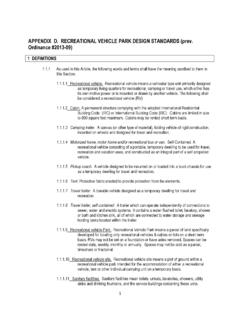Transcription of HEBRON HISTORIC DISTRICT COMMISSION HEBRON, NEW …
1 DESIGN GUIDELINES FOR THE HISTORIC DISTRICT 1 HEBRON HISTORIC DISTRICT COMMISSION HEBRON , NEW hampshire DESIGN GUIDELINES FOR THE HISTORIC DISTRICT 1. INTRODUCTION The HEBRON HISTORIC DISTRICT COMMISSION was established by the Town in 1998. The purposes of the COMMISSION include "to safeguard the heritage of the town as it is represented in structures of historical and architectural value located, or which may be located, in an HISTORIC DISTRICT ." In 1998 the Town established the HISTORIC DISTRICT . The intent of the DISTRICT is, to preserve the scale and unique HISTORIC character of HEBRON 's town center while permitting new construction of a size, scale, and design that will be in harmony with the old. It is intended that commercial structures retain and enhance their commercial character, and that residential portions of the DISTRICT retain their residential qualities.
2 Any proposal to perform work on the exterior of an existing building (other than routine maintenance) or construct a new building within the DISTRICT requires an application to the COMMISSION and an issuance by the COMMISSION of a Certificate of Approval. The purpose of these Design Guidelines is to help the COMMISSION apply its Regulations to projects within the HISTORIC DISTRICT . As a guidance document, the Guidelines have been drafted as a set of recommendations for preferred practices, and not as a set of mandatory rules. (However, mandatory portions of the COMMISSION 's Regulations and the Town's zoning ordinance have also been incorporated into the Guidelines in certain places.) In this way, the Guidelines are intended to provide predictability by giving advance notice to property owners, developers, and other parties, while allowing for flexibility of application to each specific site and proposal.
3 The Guidelines focus upon application to new buildings and significant additions, rather than upon small-scale changes to existing buildings. The Guidelines do not apply to any other HISTORIC DISTRICT within the Town. 2. Key Character-defining Elements of HISTORIC DISTRICT New construction shall be evaluated on the basis of its compatibility with existing structures and overall affect on the HISTORIC character of the DISTRICT . This section of the Guidelines defines the key character-defining elements of the HISTORIC DISTRICT , including both buildings and landscape elements, in order to clarify the meaning of "compatibility". The settlement of the HISTORIC DISTRICT area dates from the late 18th century. The DISTRICT is organized for most of its length around the Town Common. Construction of houses, civic, and commercial buildings around the Town Common was ongoing throughout the 18th, 19th, and early 20th centuries, and examples of all of these periods of building still exist today.
4 The DISTRICT DESIGN GUIDELINES FOR THE HISTORIC DISTRICT 2 comprises approximately 100 acres, and it includes approximately 21 individual buildings, mostly residential in design and use. In general, the DISTRICT retains a high degree of integrity, both in its buildings and its landscape. A. Houses Most of the buildings within the DISTRICT are houses, dating from the 18th through 20th centuries, Architecturally the houses cover a wide range of architectural styles. Only 2 of the roughly 15 houses contained within the HISTORIC DISTRICT were built after 1940. Houses are between one and three stories tall, built of wood with clapboard or shingle exterior siding, and with pitched roofs. Additive elements such as porches, bays, and wings ensure that the larger houses remain compatible in scale with smaller ones. Houses are almost invariably located close to the street, with typical setbacks of 25 to 30 feet in depth.
5 A number of residential lots also have barns and other outbuildings. B. Civic and Commercial Buildings The civic and commercial structures also cover a range of architectural styles. Five major structures front on to the Town Common: The Church; the Village Store, the Grange/Library Building, the Chapel/Town Clerk s Office and the Academy/Town Hall. All of these buildings have shallow setbacks from the street, like the adjacent houses. All of the civic and commercial structures have clapboard exteriors. The civic and commercial buildings generally maintain a compatible scale through use of massing elements. Walls are marked by patterns of window openings that maintain a consistent balance of solid to void. As in the houses, doors and windows are almost always vertical in proportion, although sometimes several vertical windows are grouped horizontally.
6 C. Landscapes The DISTRICT shows a high degree of consistency in landscape treatment. Buildings are located on relatively small lots. Fences are relatively rare in the DISTRICT ; the lack of fences contributes to the open character of the landscape and the continuous blending of different lots. There is little or no formal landscaping. In general, grass lawns with large, mature trees extend directly to the street edge. There are no sidewalks or hard-edged curbs along the street. DESIGN GUIDELINES FOR THE HISTORIC DISTRICT 3 3. Design Criteria for the HISTORIC DISTRICT There are twelve design criteria for evaluating applications before the COMMISSION . This section of the Guidelines clarifies and expands upon these criteria, drawing upon the analysis of character-defining elements, in order to identify design approaches that are more compatible and harmonious with the DISTRICT 's HISTORIC character.
7 (Note that the criteria have been organized in a different order from that in the Regulations, in order to group them into three broad categories relating to site and landscape design, building massing, and building details and materials.) Reference is made in this section to photographs of existing buildings within the DISTRICT that serve to illustrate the design criteria; however, these references should not be taken as a requirement that new construction must historical examples. A. Site Layout and Landscape Design Criteria These criteria will be applied to the way in which a building is placed on the site relative to the street, to internal paving parking and driveway areas, and to other buildings on adjacent sites within the DISTRICT , as well as to the landscape design of the site. 1. Rhythm of Spacing of the Buildings on the Street The size of new or expanded buildings, and their location on the site relative to other structures and parking areas, should be compatible with the character of the DISTRICT , with particular attention to nearby buildings.
8 A. Projects with very large building footprints should be configured as one or more distinct building volumes, each compatible in size and location on the site with the prevailing rhythm of spacing of buildings within the DISTRICT . b. Parking areas should be placed beside or behind buildings rather than between the building and the street. 2. Percent of Lot Coverage and Setback Relative to Adjacent Structures: New or expanded buildings should be set back from the street in a manner compatible with the character of the DISTRICT , with particular attention to nearby buildings. a. Houses should be located close to the street, with a setback consistent with that of nearby buildings. b. Commercial and civic structures may be set close to the street, with a setback consistent with that of nearby buildings.
9 Depending on the nature of the use and the particular character of the site. DESIGN GUIDELINES FOR THE HISTORIC DISTRICT 4 c. Lot coverage should allow sufficient un-built area around new or expanded buildings. 3. Relationship of Landscape Elements, Built and Natural, to Existing and Adjacent Structures. For sites that are previously undeveloped or are being redeveloped, the design of landscape elements (including plantings, paving, signs, and lighting) should be compatible with the character of the DISTRICT , a. Open grass lawns with irregular placement of trees and other plantings are favored over formal landscape treatments. b. Fences, sidewalks and hard-edged curbs to paved areas are generally discouraged as inconsistent with the existing character of the DISTRICT . 4. Exterior Signs The visual impact of signs shall be consistent with the historical and architectural qualities of the DISTRICT as a whole, to promote the general visual attractiveness of the DISTRICT , and to encourage signs with names of businesses, business owners or proprietors rather than trade marks and product names.
10 A. Signs may be attached to buildings or mounted free-standing on permanent posts. b. No sign can project from a building surface more than three (3) feet. A parallel sign can project no more than ten (10) inches. Permanent window signs may not take up more than ten percent (10%) of the window area. c. Materials and lettering shall be consistent with and appropriate to the character of the DISTRICT . d. Signs shall be externally illuminated only by steady, stationary and shielded light sources directed solely at the sign, without causing glare for motorists, pedestrians or neighboring premises. Animated, moving and trailer type portable electric temporary signs shall be prohibited. B. Building Massing Criteria These criteria will be applied to the three-dimensional massing of the building ( , the size, shape, and relationship of its major exterior forms) and to how that massing is placed relative to the street and to other buildings on adjacent sites within the DISTRICT .





